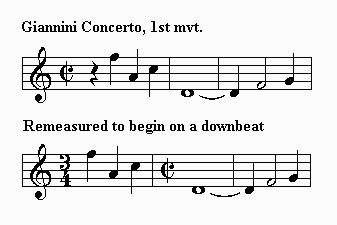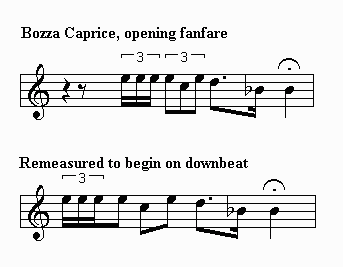
Several years ago I attended a master class at the National Trumpet Symposium, given by Gilbert Johnson, the Professor of Trumpet at the University of Miami. I vividly remember the improvement he made in one of the student's playing by making a very simple suggestion. The student was playing the first movement of the Giannini Concerto. In cut time the trumpet's initial entrance begins on an after-beat (see below). The student was a fine player, generally having a very nice, full resonant tone. However, on the first few notes of this entrance his tone quality was noticeably, and consistently pinched and un-focused. Gil asked him to play the first three quarter notes as a measure of 3/4, starting on the downbeat of the measure. The problem was instantly corrected - every note had a free, resonant tone quality!

A few years ago, I had a graduate student, a fine player, but who was having some very unusual difficulties with Bozza's Caprice - he simply could not get a tone started on the opening triple-tongued fanfare. Following the eighth rest on beat two, he absolutely could not get a tone to sound! After several suggestions which still gave no results, I finally had him re-measure the figure so it would start on a downbeat rather than an upbeat (see examples). It worked!

The problem, I believe, is that we are conditioned to basing our rhythmic pulse upon downbeat activity. When there is no sound on the downbeat, i.e. a rest, we try to substitute something else on the beat such as a grunt in our throat. Most of us who have experienced playing endless afterbeats in a march are familiar with the technique of making a little grunt in our throat on all of the beats, so we can keep the rhythm of the off-beats steady. In this repetitious activity of alternating between a closing of the throat and playing a tone, we are able to play the tone with an open un-restricted air passage. However, I have observed many players who tend to close their throats on the downbeats in passages such as those above, and are not able to entirely relax and open their air passage for the tone which comes on the afterbeat.
I have found that I am always more comfortable beginning a passage on a downbeat rather than an afterbeat and that is it very easy to simply re-measure the music mentally. In my recent discussions on single-tonguing, I suggested that you think of beginning the opening excerpt from Ravel's Piano Concerto in G major on the downbeat of a 3/8 measure rather than starting it after a sixteenth rest to give better focus, better rhythm, and to keep the throat open. See Ravel opening . In your next practice session why don't you try displacing some of the offbeat entrances to downbeats and just see if perhaps you feel a bit more secure.